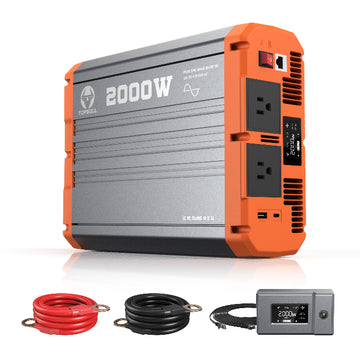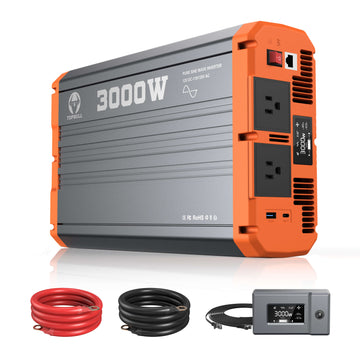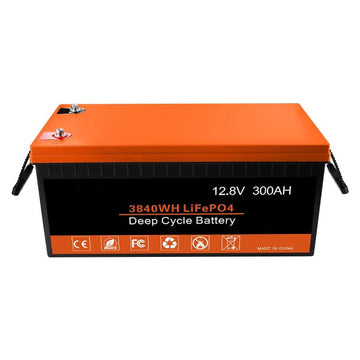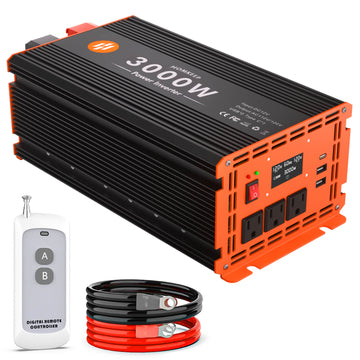Fridges have become a necessity when camping, RVing, or in the event of a power outage to keep food fresh. However, if the inverter is not powerful enough, the fridge may not start, trip frequently, or even damage the equipment. Data show that more than 60% of inverter failures are due to power mismatch. In this article, we will analyze how to choose the right inverter power for your fridge to ensure its proper operation.
What size inverter is needed to run your fridge
To run a fridge, you typically need an inverter rated between 500 watts and 2,000 watts, depending on the fridge's power consumption and startup needs.
Inverter size recommendation
| Fridge type | Power range | Recommended inverter power |
| Small fridge | 100W-300W | 500W-1000W |
| Medium fridge | 300W-600W | 1000W-1500W |
| Large fridge/double door | 600W-1200W | 1500W-2000W |
| Side door fridge | 600W-1000W | 1500W-2000W |
| Wine cooler/freezer | 100W-400W | 500W-1000W |
Understanding the power range of your fridge is the first step
The power of different types of fridges varies widely. In general:
-
Residential fridges: typically draw between 100 watts and 800 watts, depending on the size of the fridge and the energy efficiency rating.
-
Commercial fridges: These fridges have a larger capacity and typically draw between 500 watts and 1,500 watts.
- Portable fridges: small portable fridges are usually lower in power consumption and may range from 30 watts to 100 watts.
Knowing the specific model of your fridge and its power range is the first step in choosing the right inverter.
Starting Power Determines Minimum Inverter Requirements
The compressor of a fridge requires an instantaneous high current to start (starting power), while only a steady current is required during operation (running power). The starting power is usually 2-3 times the running power, e.g. a fridge with a running power of 150 W may have a starting power of 450 W. Therefore, the peak power of the inverter must cover the starting power, otherwise the fridge may not start or may trip frequently.
Total Power Requirements
When choosing the power of the inverter, you need to consider the power rating and start-up power of the fridge, as well as include the power requirements of any other equipment that will be in use at the same time (e.g., ice cube makers, small freezers, etc.). Ensure that the power of the inverter meets the combined demand of all equipment.
Increasing the safety margin
To ensure that the inverter can work stably, it is recommended to select its power 20-30% higher than the starting power and rated power of the fridge. Such a margin can effectively avoid overloading due to power spikes when the device starts up.
Example: If your fridge is rated at 500 watts and has a start-up power of 1,000 watts, then the safe inverter power is roughly: Inverter power = Start-up power × 1.3 = 1,000 watts × 1.3 = 1,300 watts.
So to run a fridge rated at 500 watts, you would need an inverter with more than 1300w of power.
Types of Inverters to Run Your Refrigerator and Choices
Modified Sine Wave Inverter vs. Pure Sine Wave Inverter
- Modified Sine Wave Inverter: Relatively inexpensive for basic appliances but may not be friendly to some fridges, especially high efficiency or high end models, which may result in erratic operation or shortened lifespan of the unit.
- Pure Sine Wave Inverter: This type of inverter provides smooth and consistent power output and is best suited for most household appliances, including fridges. Although it is more expensive, it is safer and more stable.
Consider the efficiency of the inverter
Choosing a high-efficiency inverter (e.g., 95% and above) reduces power loss and allows the battery (if used) to power the device for a longer period of time. This not only improves the efficiency of the device, but also extends battery life.
Recommended inverter sizes for different scenarios
Car Camping Fridge
Power Requirements
-
Running Power: 50W-150W (small car fridge)
- Starting Power: 150W-450W (need to cover the startup peak)
Product Recommendation: 300W Pure Sine Wave Car Inverter
Product Features:
-
Compact Size: fits into the narrow car space and weighs only 1-2kg.
-
Multi-Interface Design: supports USB charging (5V/ 2.4A) and 12V cigarette lighter interface, compatible with cell phones, tablets and other devices.
-
Intelligent protection: overload, over-temperature and short-circuit protection to prevent the vehicle battery from losing power.
- Affordable price: $300-500 range, cost-effective.
Household refrigerator power failure emergency
Power Requirement:
-
Running Power: 100W-250W (household single-door/double-door fridge)
- Starting Power: 300W-750W (need to reserve enough margin)
Product Recommendation: 1000W Pure Sine Wave Inverter
Product Features:
-
Continuous Power 1000W: It can satisfy the running and starting requirements of most household refrigerators, and at the same time, it can support the charging of other small electrical appliances (such as lighting and cell phones). (such as lighting and cell phone charging).
-
Multiple interfaces: output multiple USB, AC and DC sockets, suitable for powering multiple devices at the same time, flexible to use.
- Built-in lithium battery: lightweight, durable and can be moved to the desired location at any time, ideal for power outage emergencies.
RV Traveling
Power Requirement
- Need to power devices such as fridge, microwave and lighting at the same time, power range: 800W-2000W
Product Recommendation: Topbull 2000w Pure Sine Wave Inverter

Product Features
-
Powerful Power Output: supports up to 2000W power with a peak value of 4000W, capable of running fridge, microwave and lighting at the same time, perfect for RV use.
-
Pure Sine Wave Design: Ensures stable and damage-free operation, suitable for appliances with high power requirements.
- Compact Design & Easy Installation: Designed for RVs, it does not take up too much space and is easy to use anytime you are on the road.
FAQs
1. Will a 1500 watt inverter run a refrigerator?
A. Yes, a 1500 watt inverter will usually run most household fridges without problems. Most domestic refrigerators run between 100W and 250W, and may have a start-up power of 400W to 750W, so a 1500W inverter will not only meet the start-up needs of the fridge, but will also provide power for other equipment.
2. Can a 600W inverter run a fridge?
A: Possibly. A 600W inverter can run a fridge with a power of up to 400W, including its starting power. However, if the fridge runs at more than 400W (e.g., 150W rated power, 450W start-up power), a 600W inverter may not be adequate. When selecting an inverter, consider the specific power data and safety margins of the fridge being used.
3. Will a 3000 watt inverter run a refrigerator?
A: Yes, a 3000 watt inverter is sufficient to power almost any type of fridge, and can even drive multiple high power devices at the same time. For most household fridges, a 3000 watt inverter provides far more power than is needed, so you can use it with confidence.
4. Does using an inverter affect the fridge? Will it affect the cooling effect?
A: If you choose an inverter with enough power and stable output voltage, it usually does not negatively affect the cooling effect of your fridge. On the contrary, using the right inverter can ensure the fridge to operate normally without power supply and avoid frequent power fluctuations that may cause damage to the fridge.
5. Under what circumstances should I consider a higher power inverter?
A: You should consider a higher power inverter in the following situations:
- Higher fridge starting power: If the starting power of the fridge is close to or exceeds the rated power of the inverter.
- Multiple devices at the same time: If you plan to power multiple devices at the same time, such as fridges and microwave ovens, you need to choose a higher power inverter to meet the total power demand.
- Safety margins: If additional safety margins are desired to prevent accidental overloads.
- Aging equipment: For older equipment, the starting power may be higher, so a higher power output needs to be considered.
6. Will frequent fridge starts shorten the life of the inverter?
A: Yes, frequent fridge starts may shorten the life of the inverter. Frequent starts and stops cause fluctuations in the inverter's electrical load, increasing heat and wear and tear, which can affect the life of its internal components. Choosing an inverter with the right power and stable output can help minimize this effect.













